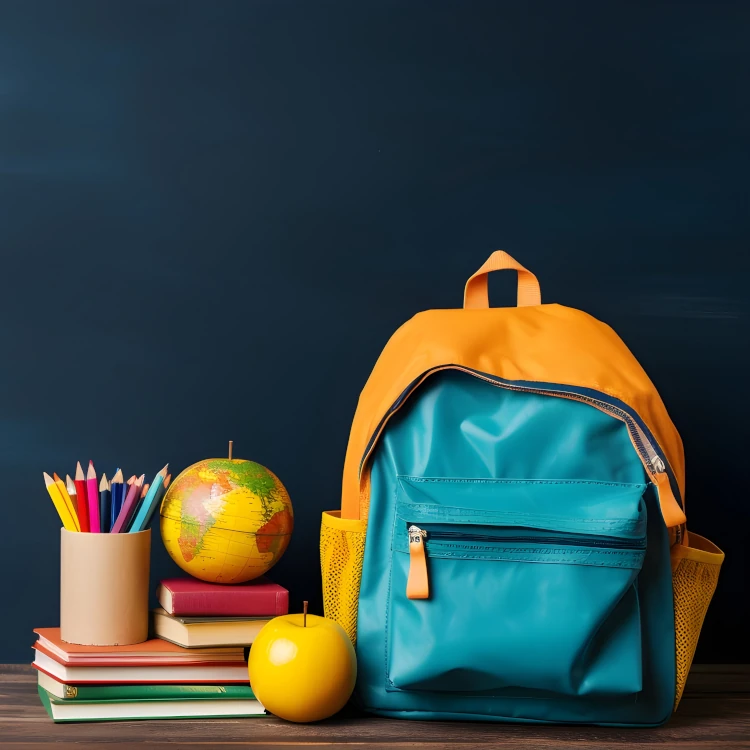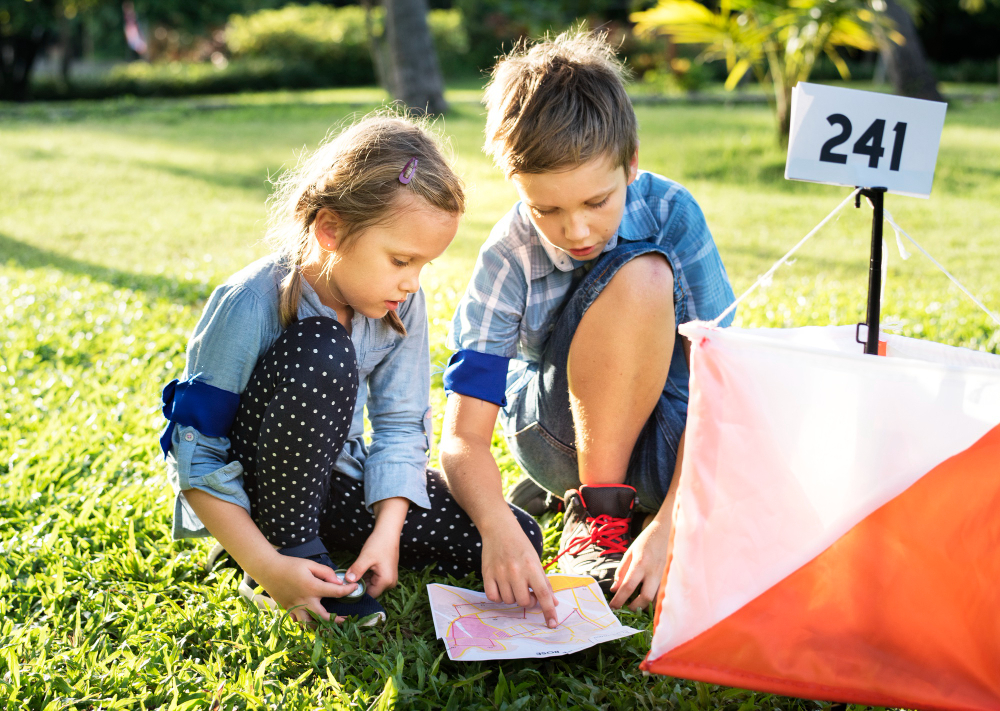Smooth Sailing: A Guide to Transitioning Back to School-Year Routine During Summer

As the lazy days of summer roll in, the idea of transitioning back to a school-year routine might seem like a daunting task. However, with a bit of planning and a gentle approach, you can make the shift seamlessly, setting the stage for a successful start to the academic year. Here’s a guide to help you navigate the transition and make the most of the remaining summer days: 1. Gradual Wake-Up Calls Start adjusting sleep schedules gradually. Begin by setting the alarm 15 minutes earlier each day until you reach the desired wake-up time for the school year. This gradual approach helps the body and mind acclimate to the earlier morning routine. 2. Create a Daily Schedule Structure is key when transitioning back to a school-year routine. Create a daily schedule that includes designated times for meals, study sessions, and recreational activities. Having a routine helps establish a sense of normalcy and predictability. 3. Reintroduce Learning Activities Rekindle the learning spirit by incorporating educational activities into the daily routine. This could include reading books, engaging in educational games, or exploring educational apps. Keep it light and enjoyable to maintain a positive association with learning. 4. Set Goals and Expectations Discuss expectations for the upcoming school year with your child. Establish academic and personal goals, and emphasize the importance of a positive mindset. This conversation can help create a sense of purpose and motivation. 5. Organize School Supplies Use the summer break to get a head start on school preparations. Organize school supplies, purchase any necessary items, and create a designated study space. Having everything in order reduces last-minute stress as the school year approaches. 6. Reintegrate Bedtime Routines Reinstate bedtime rituals that may have been relaxed during the summer. Whether it’s a calming bedtime story, gentle music, or a warm bath, these routines signal to the brain that it’s time to wind down and prepare for restful sleep. 7. Family Calendar Create a family calendar that includes important dates for the upcoming school year. This could include orientation days, extracurricular activities, and project deadlines. Having a visual reference helps everyone stay on the same page. 8. Encourage Independence Foster a sense of independence by encouraging your child to take on responsibilities related to the school routine. This could include packing their own backpack, organizing school materials, and managing their time effectively. 9. Celebrate the Transition Make the back-to-school transition a positive experience by celebrating it. Plan a special family outing or a back-to-school dinner to mark the occasion. Creating positive associations can make the transition more enjoyable for everyone involved. 10. Flexibility and Patience Understand that transitioning back to a school-year routine is an adjustment for the entire family. Be patient and flexible, allowing room for adaptation. Celebrate small victories and provide support as needed. By approaching the transition with a thoughtful and gradual mindset, you can turn the back-to-school process into a smooth and positive experience for both you and your child. Embrace the remaining days of summer while laying the foundation for a successful start to the school year.
Navigating the Seas of Vacation Travel: A Guide to Taming Stress and Enjoying the Journey

As the excitement of vacation approaches, so does the potential for travel stress. From packing woes to navigating crowded airports, the journey to your dream destination can sometimes feel like a hurdle rather than an adventure. Fear not! With a bit of preparation and a positive mindset, you can transform your travel experience from stressful to seamless. Here’s a guide to help you deal with vacation travel stress and make the most of your journey: 1. Plan Ahead The key to a stress-free vacation begins with meticulous planning. Create a checklist of essential items, make reservations in advance, and familiarize yourself with the travel itinerary. Having a well-thought-out plan can alleviate last-minute panic. 2. Pack Strategically Packing can be a significant source of stress. Start packing early and make a checklist of items you’ll need. Consider the weather at your destination and pack accordingly. Roll clothes to save space, and use travel-sized containers for toiletries. 3. Arrive Early Whether it’s a flight or a road trip, arriving early can spare you the anxiety of rushing. Allow extra time for unexpected delays, security checks, and traffic. Early arrival provides a buffer, ensuring a smoother start to your vacation. 4. Entertainment and Comfort Long journeys can be tedious, so pack entertainment essentials. Bring a good book, download movies, or create a playlist. Additionally, pack items that enhance comfort, such as a neck pillow, blanket, or snacks to keep you energized. 5. Stay Hydrated and Well-Fed Dehydration and hunger can exacerbate stress. Keep a water bottle handy and pack nutritious snacks. If traveling by plane, be mindful of in-flight meal times, or bring your own snacks to avoid relying solely on airline offerings. 6. Mindful Breathing and Relaxation Techniques When stress levels rise, take a moment to practice mindful breathing. Inhale deeply, hold for a few seconds, and exhale slowly. Relaxation techniques can help calm nerves and make the travel experience more enjoyable. 7. Stay Connected but Set Boundaries While staying connected is essential, set boundaries for work-related communication during your vacation. Inform colleagues and clients of your limited availability, allowing you to truly unwind without the constant ping of emails. 8. Flexibility is Key Understand that not everything will go according to plan. Flight delays, traffic jams, and unexpected detours are all part of the travel experience. Embrace flexibility, go with the flow, and find the silver lining in unexpected situations. 9. Utilize Travel Apps Take advantage of travel apps that provide real-time updates on flights, traffic, and accommodation. These apps can be invaluable for navigating through unforeseen challenges and keeping you informed throughout your journey. 10. Positive Mindset Approach your vacation with a positive mindset. Focus on the excitement of the destination rather than the stress of the journey. Remind yourself that the travel experience is an integral part of the adventure, and each step brings you closer to your dream vacation. By incorporating these tips into your travel routine, you can minimize stress and maximize the enjoyment of your vacation. Remember, the journey is just as important as the destination, so embrace the adventure and savor every moment along the way. Safe travels!
Unlocking a Summer of Learning: Tips to Keep Kids Engaged and Inspired

As the school doors close for the summer, it’s the perfect time to embark on a different kind of learning journey. While the break offers a chance for relaxation, it’s essential to keep the gears of curiosity turning. Here are some tips to ensure that the summer is not only a time for fun and play but also a season of continued growth and learning for your kids: 1. Create a Summer Reading List: Encourage a love for reading by curating a summer reading list tailored to your child’s interests. Visit the local library together to pick out books, or explore online platforms for e-books and audiobooks. Set aside dedicated reading time each day. 2. Engage in Educational Games: Make learning fun through educational games and activities. Board games, puzzles, and interactive apps can enhance critical thinking and problem-solving skills. Look for games that align with subjects your child enjoys or needs additional practice in. 3. Explore Nature: Summer provides the perfect backdrop for outdoor exploration. Plan nature walks, visits to parks, or even camping trips. Use these experiences to teach kids about local flora and fauna, ecosystems, and the importance of environmental conservation. 4. Cooking and Math: Turn cooking into a learning experience by involving your child in the kitchen. Cooking not only teaches valuable life skills but also incorporates math concepts such as measurements and fractions. Try out new recipes together and make it a family affair. 5. Creative Writing and Journaling: Encourage your child to keep a summer journal. Whether it’s documenting daily activities, writing short stories, or even creating a personal blog, journaling fosters creativity and improves writing skills. 6. Hands-On Science Experiments: Transform your home into a mini science lab. Conduct simple experiments that can be done with household items to explore scientific principles. This hands-on approach makes learning science exciting and memorable. 7. Learn a New Skill: Summer is an excellent time for your child to pick up a new skill or hobby. Whether it’s learning a musical instrument, a new language, or honing artistic abilities, these activities contribute to cognitive development and personal growth. 8. Museum and Cultural Visits: Plan visits to museums, cultural exhibits, and historical sites. Many institutions offer interactive exhibits and workshops for children. These outings can spark interest in history, art, and science. 9. Online Learning Platforms: Leverage online learning platforms that offer educational content suitable for various age groups. Many websites provide interactive lessons, quizzes, and educational videos across a wide range of subjects. 10. Family Learning Challenges: Turn learning into a family affair by introducing friendly challenges. Whether it’s a weekly trivia night, a creative project, or a science experiment, involving the whole family fosters a supportive learning environment. Remember, the key is to balance learning with enjoyment. Summer is a time for exploration, and by incorporating these tips, you can ensure that your child’s curiosity continues to thrive during the break. Embrace the joy of discovery and make this summer a season of both relaxation and enrichment for your family.
Learning Beyond the Classroom: Fun and Educational Summer Tips for Kids

As the school doors close for the summer, parents often wonder how to keep the momentum of learning alive in the midst of all the sunshine and playtime. The good news is that learning doesn’t have to take a vacation. Here are some tips to ensure that your child’s curiosity continues to thrive during the summer months: 1. Explore Outdoor Learning: Take advantage of the warm weather by turning outdoor activities into learning opportunities. Visit parks, nature reserves, or botanical gardens to explore science and nature. Identify different plants and animals, and encourage your child to ask questions about the world around them. 2. Reading Adventures: Create a summer reading challenge with a variety of books that cater to your child’s interests. Set a goal together, and reward achievements with small incentives. Whether it’s a trip to the bookstore or a special treat, turning reading into a game can make it more enjoyable. 3. Educational Apps and Games: There are numerous educational apps and games designed to make learning enjoyable. Explore interactive platforms that cover subjects like math, science, and language arts. Many of these apps incorporate gamified elements, making the learning experience engaging and entertaining. 4. Creative Arts and Crafts: Encourage artistic expression through summer-themed arts and crafts projects. This not only enhances creativity but also develops fine motor skills. Create a DIY art corner and let your child’s imagination run wild with various materials. 5. Cooking and Math: Turn the kitchen into a learning laboratory. Involve your child in measuring ingredients, following recipes, and understanding the science behind cooking. It’s a delicious way to reinforce math skills and introduce concepts like fractions and measurements. 6. Science Experiments: Spark scientific curiosity by conducting simple experiments at home. Whether it’s creating a volcano with baking soda and vinegar or exploring the principles of buoyancy with a sink-or-float experiment, hands-on activities make learning fun. 7. Family Field Trips: Plan educational field trips to museums, science centers, or historical sites. Many places offer special summer programs for kids. These outings not only provide valuable learning experiences but also create lasting family memories. 8. Journaling and Storytelling: Encourage your child to keep a summer journal where they can document their adventures, thoughts, and experiences. This not only improves writing skills but also serves as a cherished keepsake. Consider a weekly storytelling session where your child can share their journal entries. 9. Math in Everyday Life: Integrate math into daily activities. Whether it’s counting steps during a walk, measuring ingredients while cooking, or budgeting for a summer treat, incorporating math into everyday life makes it more practical and relatable. 10. Community Involvement: Engage in community service or volunteer work together. This fosters a sense of responsibility and social awareness. It also provides opportunities to learn about different cultures, social issues, and the importance of giving back. Conclusion: Embracing a Summer of Learning Fun Summer is a fantastic time for kids to explore, discover, and learn in ways that may not be possible within the confines of a classroom. By infusing learning into everyday activities and maintaining a spirit of curiosity, you can ensure that your child’s educational journey continues to flourish throughout the summer months. After all, the best lessons are often learned through the joy of exploration and play. Happy summer learning!
Finish Strong: A Guide to Wrapping Up the School Year with Success

As the school year enters its final stretch, it’s easy to feel overwhelmed by looming deadlines, exams, and the anticipation of summer. However, finishing the academic year strong is not only possible but can set the stage for a satisfying and well-deserved break. Here’s a guide to help you navigate the last leg of the school year and emerge victorious: Prioritize Tasks Create a list of remaining assignments, projects, and exams. Prioritize them based on deadlines and importance. Tackling tasks in a structured manner can help prevent last-minute cramming and reduce stress. Time Management Efficient time management is crucial during this period. Create a study schedule that allocates dedicated time for each subject or task. Break your study sessions into manageable chunks, allowing for better focus and retention. Seek Support Don’t hesitate to reach out to teachers, classmates, or support services if you’re struggling with any concepts. Collaboration can lead to a deeper understanding and make the workload more manageable. Healthy Habits It’s tempting to sacrifice sleep and nutrition during the final weeks, but this can negatively impact your performance. Prioritize a balanced diet, regular exercise, and sufficient sleep to ensure your mind and body are operating at their best. Review and Revise Take the time to review class notes and materials. Identify areas where you may need additional clarification or practice. Active revision ensures that you have a solid grasp of the material, boosting your confidence for exams. Stay Positive Maintaining a positive mindset can significantly impact your performance. Celebrate small victories, and remind yourself of the progress you’ve made throughout the year. Visualize success to build confidence and motivation. Breaks and Rewards Incorporate short breaks into your study sessions to prevent burnout. Reward yourself with small treats or activities after completing challenging tasks. This will keep you motivated and make the workload more manageable. Organization is Key Keep your study space organized and clutter-free. Having a clear workspace can enhance focus and efficiency. Use tools like calendars and to-do lists to stay on top of deadlines and responsibilities. Reflect and Set Goals Take a moment to reflect on your academic journey this year. Acknowledge your achievements and identify areas for improvement. Use this insight to set realistic goals for the upcoming school year. Celebrate Achievements When the final exams are over and the projects submitted, take time to celebrate your accomplishments. Whether it’s a small treat, a day out, or simply relaxing at home, acknowledging your hard work is essential for maintaining a healthy balance. Remember, finishing the school year strong is not just about academic success; it’s about personal growth and resilience. By approaching the remaining weeks with determination, organization, and a positive mindset, you can overcome challenges and end the school year on a high note. Best of luck!
Unraveling the Challenges: Navigating Learning with Dyslexia

In the diverse tapestry of learning, each individual weaves a unique story. However, for those with dyslexia, the journey can be marked by distinct challenges that require a compassionate and informed approach. This blog aims to shed light on how dyslexia affects learning and explore strategies that can transform obstacles into opportunities for growth and success. Reading Difficulties Dyslexia is often associated with challenges in reading, spelling, and decoding words. The conventional methods of teaching reading may not align with the learning style of individuals with dyslexia, making it a formidable hurdle in their academic journey. Strategy: Adopting multi-sensory approaches to reading, such as incorporating visual aids, auditory cues, and kinesthetic activities, can enhance comprehension and retention. Providing extra time for reading assignments and utilizing audiobooks can offer alternative pathways to accessing information. Spelling and Writing Challenges Dyslexia can impact spelling accuracy and written expression. Individuals may struggle with letter reversals, inconsistent spacing, and difficulty organizing thoughts coherently on paper. Strategy: Introducing assistive technologies like spell-check tools and speech-to-text software can alleviate the pressure associated with spelling and writing tasks. Encouraging the use of graphic organizers and mind maps can help organize ideas before translating them into written form. Working Memory and Processing Speed Dyslexia can affect working memory and processing speed, making it challenging for individuals to quickly retrieve and manipulate information. Strategy: Breaking down tasks into smaller, more manageable steps and providing ample time for processing can support individuals with dyslexia. Offering clear instructions, both written and verbal, can enhance comprehension and reduce the cognitive load. Self-esteem and Motivation Repeated struggles in traditional learning environments can take a toll on the self-esteem and motivation of individuals with dyslexia. Feelings of frustration and inadequacy may hinder their overall engagement in the learning process.Strategy: Fostering a supportive and inclusive learning environment is crucial. Recognizing and celebrating individual strengths, providing positive reinforcement, and offering opportunities for success can contribute to building a resilient mindset. Conclusion Understanding how dyslexia affects learning is pivotal in creating an educational landscape that values neurodiversity. By embracing tailored strategies and leveraging assistive technologies, educators and caregivers can empower individuals with dyslexia to thrive academically and beyond. It is through a collective commitment to inclusivity and empathy that we can unravel the challenges posed by dyslexia, transforming the learning journey into a tapestry of resilience, growth, and achievement.
Navigating the Learning Landscape with ADHD: Unveiling the Challenges and Strategies

The journey of learning is unique for each individual, shaped by various factors that contribute to one’s cognitive and emotional development. However, for those navigating the terrain with Attention-Deficit/Hyperactivity Disorder (ADHD), the path can be peppered with distinct challenges that require a nuanced understanding. In this blog post, we’ll explore how ADHD affects learning and shed light on strategies that can pave the way for a more supportive educational experience. Attention Challenges ADHD is often characterized by difficulties in sustaining attention. In a traditional learning environment, where focus is key, individuals with ADHD may find it challenging to stay engaged in tasks for extended periods. Distractions, both internal and external, can divert attention away from the intended learning objectives. Strategy: Implementing structured routines, breaking down tasks into manageable chunks, and incorporating interactive learning methods can help maintain focus. Additionally, providing a quiet and minimally distracting learning environment can create a conducive space for concentration. Impulsivity Impulsivity is another hallmark of ADHD, making it difficult for individuals to think before acting. In a classroom setting, impulsive behavior can disrupt the flow of lessons and hinder effective learning for both the individual and their peers. Strategy: Teaching and encouraging self-monitoring techniques can empower individuals with ADHD to pause and reflect before responding impulsively. Introducing mindfulness practices can also contribute to increased self-awareness and better impulse control. Working Memory Challenges Individuals with ADHD may experience difficulties with working memory, affecting their ability to retain and manipulate information over short periods. This can pose challenges in tasks that require sequential processing and quick recall. Strategy: Employing visual aids, such as charts, diagrams, and graphic organizers, can enhance memory retention. Additionally, incorporating repetition and review into the learning process can reinforce key concepts and improve information retention. Hyperactivity The hyperactive component of ADHD can manifest as excessive fidgeting, restlessness, and difficulty sitting still. In a classroom setting, this behavior can be misconstrued as disruptive, leading to potential social and academic challenges. Strategy: Providing opportunities for movement breaks and incorporating hands-on learning activities can channel excess energy in a positive direction. Flexible seating arrangements that accommodate different learning styles can also create a more inclusive and comfortable environment. Conclusion Understanding how ADHD affects learning is the first step towards creating an inclusive and supportive educational experience. By embracing tailored strategies that cater to the unique needs of individuals with ADHD, educators and caregivers can empower them to navigate the learning landscape more effectively. Through a collaborative effort, we can ensure that every learner, regardless of their cognitive profile, has the opportunity to thrive and unlock their full potential.
Unlocking Learning Potential: The Impact of Executive Function on Education

Introduction Executive function, a set of mental processes that facilitate goal-directed behavior, is a crucial factor in a child’s ability to learn and thrive in an educational setting. In this blog, we’ll explore the various facets of executive function and how they influence the learning experience. What is Executive Function? Executive function encompasses a range of cognitive skills, including attention control, working memory, cognitive flexibility, and self-control. These skills act as the brain’s “CEO,” managing and coordinating other mental processes to achieve specific goals. Attention Control: The Gateway to Learning Attention is the foundation of all learning. Children with strong executive function can sustain attention, filter out distractions, and focus on the task at hand. This skill is crucial for absorbing information in the classroom and during independent study. Working Memory: The Mental Notepad Working memory allows students to temporarily hold and manipulate information. A robust working memory enables effective problem-solving, comprehension, and the ability to follow multi-step instructions—essential skills for academic success. Cognitive Flexibility: Adapting to Change Learning environments are dynamic, and cognitive flexibility allows students to adapt to new information and shifting demands. Children with well-developed executive function can easily transition between tasks, subjects, and classroom activities. Self-Control: The Key to Academic Persistence Self-control is vital for regulating emotions and impulses. Students with strong executive function can manage frustration, delay gratification, and stay focused on long-term goals, contributing to academic persistence and achievement. Executive Function Challenges in Learning Disabilities Some students may face challenges in developing executive function, often associated with learning disabilities such as ADHD or dyslexia. Understanding and addressing these challenges early on can significantly improve educational outcomes. Strategies to Support Executive Function in Learning: Collaboration Between Home and School Effective communication between parents and teachers is essential. Sharing insights about a child’s executive function strengths and challenges ensures a cohesive and supportive approach to their education. Conclusion Recognizing the impact of executive function on learning is a crucial step in creating a positive and effective educational experience for every child. By understanding and nurturing these cognitive skills, parents and educators can empower students to overcome challenges and unlock their full learning potential.
Nurturing Young Writers: A Guide to Cultivating Your Child’s Writing Skills

Introduction As a parent, you play a crucial role in shaping your child’s future, and one of the essential skills you can help them develop is writing. Writing not only enhances communication but also fosters creativity and critical thinking. In this blog, we’ll explore some practical tips to assist your child in honing their writing skills and, more importantly, making the process enjoyable. Create a Writing-Friendly Environment Set the stage for creativity by providing a comfortable and inspiring writing space. Ensure your child has access to paper, pens, and other writing tools. Consider placing a small desk or a cozy nook where they can retreat to unleash their imagination. Encourage Daily Journaling Encourage your child to keep a journal. Whether it’s a diary of daily activities, thoughts, or even fictional stories, journaling helps improve writing fluency and creativity. Make it a habit for your child to jot down their thoughts and experiences regularly. Read Together Reading is the foundation of good writing. Introduce your child to a variety of books and genres. Reading together not only enhances their vocabulary but also exposes them to different writing styles. Discuss the stories, characters, and plot elements to stimulate their analytical thinking. Be a Writing Role Model Children often learn by example. Let them see you engaging in writing activities, whether it’s composing emails, creating shopping lists, or even writing a short story. Demonstrating your own love for writing can inspire and motivate them to follow suit. Provide Constructive Feedback When your child shares their writing with you, offer constructive feedback. Focus on the positive aspects first, praising their effort and creativity. Then, gently suggest areas for improvement. Encourage them to revise and edit their work, teaching them that writing is an evolving process. Explore Writing Prompts Introduce fun and interesting writing prompts to spark their creativity. You can find various prompts online or create your own based on your child’s interests. These prompts can serve as fantastic starting points for short stories, essays, or even imaginative pieces. Make Writing a Collaborative Activity Collaborative writing can be a great way to make the process enjoyable. Engage in writing activities together, whether it’s co-authoring a story or creating a family newsletter. Collaboration not only enhances their writing skills but also strengthens the parent-child bond. Celebrate Achievements Celebrate your child’s writing achievements, no matter how small. Display their work on a dedicated “writing wall” or create a portfolio to showcase their progress. Positive reinforcement boosts their confidence and encourages them to continue developing their skills. Conclusion By fostering a love for writing and providing the right support, you can help your child become a confident and skilled writer. Remember that the journey is as important as the destination, so enjoy the process together and watch as your child’s writing skills flourish.
Reading Comprehension

Absolutely, fostering strong reading comprehension skills in children is crucial. Here are some blog tips to help parents support their child’s reading comprehension: Create a Reading Routine Establish a consistent reading routine at home. Set aside dedicated time for reading each day, creating a comfortable and quiet environment. Choose Age-Appropriate Books Select books that align with your child’s age and interests. This ensures they stay engaged and can relate to the content, making comprehension more enjoyable. Ask Questions Before, During, and After Reading Encourage active reading by asking questions. Before reading, discuss the title and cover. During reading, inquire about characters, plot, and predictions. Afterward, discuss the story’s main points. Build Vocabulary Use Visual Aids Utilize pictures and illustrations in books to enhance understanding. Encourage your child to describe what they see and connect it to the text. Make Connections Help your child relate the story to their own experiences. This personal connection can deepen comprehension and make the reading experience more meaningful. Encourage Summarization Teach your child to summarize what they’ve read in their own words. This helps reinforce understanding and promotes the ability to extract key information. Read Aloud Together Reading aloud together allows you to model proper pronunciation, expression, and intonation. It also provides an opportunity for discussion as you progress through the story. Visit the Library Regular library visits expose your child to a variety of books and genres. This broadens their reading experience and introduces them to different writing styles. Be Patient and Supportive Every child progresses at their own pace. Be patient, offer positive reinforcement, and celebrate their achievements. Building strong reading comprehension takes time and encouragement. Remember, the goal is to make reading an enjoyable and enriching experience for your child.



